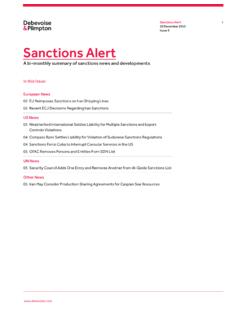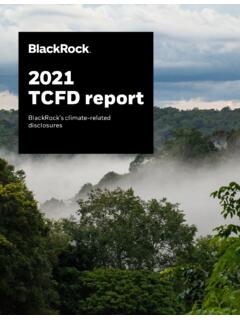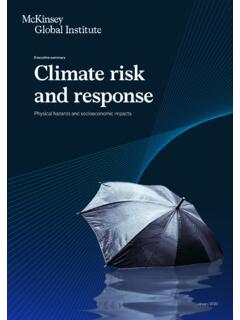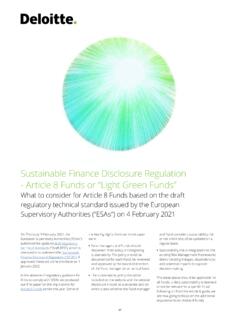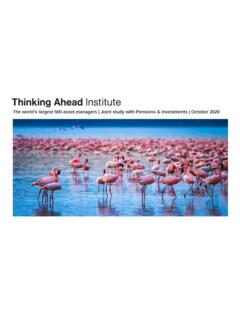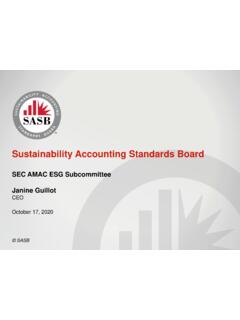Transcription of ESG in the Insurance Sector: Growth, Opportunities and Risks
1 Debevoise In Depth 6 January 2021 With the recent news that Apollo Lloyd s will no longer underwrite Adani s Carmichael coal mine in Australia following the expiry of the policy in 2021, it has never been more apparent that (re)insurers around the world are displaying a deep interest in environmental, social and governance ( ESG ) factors. For example, in December 2020, Lloyd s published its first ESG report, in which it announced that for the first time they would be setting targets for responsible underwriting and investment, in particular by asking managing agents, from 1 January 2022, to stop accepting new business on certain coal and oil activities and to phase out existing coverage by 1 January 2030. ESG Risks have resulted in increasing numbers and quantum of insured claims, and therefore losses to carriers, and are also linked to other legal and, crucially, reputational concerns. The ongoing activity of governments and the spotlight being shone by activists on these issues has led to an increasing amount of ESG-related legislation (largely focused on disclosure of Risks and other ESG factors).
2 Although adapting to ESG Risks is expected to reduce costs for companies in the longer term, in the short term, this greater regulatory burden represents a cost to all firms, including (re)insurers. This compliance burden is significant for international (re) Insurance groups subject to standards that diverge between jurisdictions, such as the marked contrast between the relatively and increasingly stringent requirements of the European Union (the EU ) and the lack of any standardised ESG disclosure regime in the United States. However, compliance with ESG reporting requirements and foregrounding ESG within investment strategies may also offer Opportunities for insurers, such as attracting the growing number of ESG-minded consumers, as well as having the potential to enable positive financial returns on investments (see, for example, blackrock s announcement of its commitment to assessing ESG with the same rigor that it analyses traditional measures such as credit and liquidity risk ).
3 By successfully integrating ESG factors into their risk assessment and underwriting processes, (re)insurers may be able to mitigate their losses from the growing number and range of ESG Risks . To ensure the success of their businesses going forward, (re)insurers must prioritise consideration of ESG factors, both in their roles as investors and as (re)insurers. ESG in the Insurance Sector: Growth, Opportunities and Risks 6 January 2021 2 Impacts of ESG Issues The number and type of ESG Risks are growing. Perhaps the most obvious manifestations of these are the Risks posed by climate change to (re)insurers. S&P Global Ratings research estimates that 60% of S&P 500 companies own assets at a high risk from the physical impact of climate change. With the intensification of natural catastrophes and weather-related events, at least in part due to the impact of climate change, property losses from catastrophes have increased from $ billion in 2010 to $ billion in 2018; the figure for 2017 was even higher, at $111 billion, due in part to hurricanes Harvey, Irma and These events also cause significant disruption to businesses and the market, as well as climate-related migration, which in turn leads to lower property values and therefore associated revenues for (re)insurers in the areas people are abandoning.
4 While the E of ESG is important, it is not important to the exclusion of other Risks . Indeed, in the EU Regulation on sustainability -Related Disclosures in the Financial Services Sector (the Disclosure Regulation ),2 it is made clear in the definition of sustainable investment that the three branches of ESG are In AM Best s recent survey of 97 (re)insurers on ESG factors ( AM Best s Survey ), corporate governance and product liability including cyber security were cited as the most relevant ESG issues for the Insurance industry, alongside climate risk. A study by the Allianz Global Corporate & Specialty and The Value Group has shown that, in terms of social risk, health and safety trainings, employee wellbeing and investments in employee safety [..] have measurable and positive effects on employee accident and fatality levels .4 A lack of respect for human rights can also cost companies on account of disruption to their work through community protest. To take just one example, local communities have been angered by the actions of the owner of the Las Bambas copper mine in Peru MMG Ltd, in particular its decision to use trucks to transport materials to and from the mine, which allegedly generate significant levels of pollution, and the alleged failure to consult with local communities about the building of the road on their 1 Facts + Statistics: catastrophes, accessible at: #2019%20natural%20catastrophes (last accessed: 10 November 2020).
5 2 Regulation (EU) 2019/2088 of the European Parliament and of the Council of 27 November 2019 on sustainability related disclosures in the financial services sector. 3 See Article 2, Regulation (EU) 2019/2088 of the European Parliament and of the Council of 27 November 2019 on sustainability related disclosures in the financial services sector ( sustainable investment means an investment in an economic activity that contributes to an environmental objective .. or an investment in an economic activity that contributes to a social objective .. provided that such investments do not significantly harm any of those objectives and that the investee companies follow good governance practices, in particular with respect to sound management structures, employee relations, remuneration of staff and tax compliance ). 4 The predictive power of ESG for Insurance , accessible at: expert-risk- (last accessed: 3 December 2020). 6 January 2021 3 land. The ensuing protests has caused significant disruption to the mine, such that MMG Ltd has reduced its output guidance for the mine in 2020 by more than 10%,5 though the COVID-19 pandemic has been cited by the company as the cause, alongside community One major social risk is the recent spate of diversity disputes, such as the shareholder derivative action filed against Facebook in 2020, alleging that the directors violated their fiduciary duties through their failure to take action on diversity and inclusion, and hate speech.
6 These growing Risks are relevant to (re)insurers in their roles as both investors and underwriters. From an underwriting perspective, a failure to integrate all ESG factors into the risk assessment and underwriting process will misunderstand the scope of the eventualities and the related Risks that policy is covering. This will likely lead to increased claims on policies, which has the capacity to significantly reduce (re)insurers ability to derive underwriting profits on policies. A failure to consider ESG factors can also be detrimental to the value of (re)insurers investment portfolios. Companies revenues, profits and market values decline following ESG incidents such as oil spills and weather-related supply chain disruptions. If a (re)insurer invests in companies seeing a reduction in their share value, this may reduce investment returns. Taking a longer-term view, some companies may ultimately collapse in the face of Risks stemming from long-term trends such as climate change.
7 A failure to factor this in could impact the value of investment portfolios and underwriting profits (or extend underwriting losses), as well as the ability of the (re)insurer to attract investment itself, as institutional investors and consumers start to compare products and turn to those more aligned with their personal and institutional values. Risks related to, and the approach generally to, ESG issues can also impact a company s reputation. With the advent of viral social media, customers can easily express displeasure, with wide exposure, at how companies, particularly those that are public facing, have handled ESG issues. Returning to the example of the Adani mine, activists successfully targeted companies involved with a sustained social media campaign to #StopAdani. The #GoTransparent campaign calls on fashion brands to publish a list of the factories that make their branded products, and have targeted companies such as Armani and American Eagle Outfitters.
8 There is an increasing normative expectation held by investors, courts, regulators and customers that (re)insurers should comply 5 UPDATE 1-MMG says Las Bambas copper shipments back to normal, cuts 2020 guidance, accessible at: (last accessed: 14 December 2020). 6 Transport convoy from major Chinese-owned copper mine attacked in Peru Reuters, accessible at: (last accessed: 14 December 2020). 6 January 2021 4 with ESG expectations and put ESG issues at the forefront of their decision-making. As discussed above, not doing so may damage (re)insurers reputations and growth, from both an underwriting and investment perspective. Reducing reputational risk was the most-cited reason behind (re)insurers integration of ESG factors in investing mandates by the respondents to AM Best s Survey. ESG Disclosure Requirements ESG legal frameworks are currently focused on diligence, disclosure and reporting obligations so as to allow investors and interested parties to bring pressure to bear on those who do not meet expected or mandated targets and/or requirements.
9 Such laws can have a significant impact on furthering the consideration of ESG issues. Indeed, in AM Best s Survey, almost half of the respondents chose legislators or regulators as a source of high or significant stakeholder pressure for considering ESG Risks and Opportunities . The UK On 9 November 2020, the UK s joint Government-Regulator Task Force on Climate-related Financial Disclosures ( TCFD )7 announced its intention to make TCFD-aligned disclosures mandatory across the economy by 2025, alongside the publication of its Interim Report and Roadmap. The Roadmap sets out that (re)insurers will likely be subject to mandatory disclosures by the end of 2021. The Chancellor also announced that the UK would implement a green taxonomy, which would take the scientific metrics in the EU taxonomy as its basis and a UK Green Technical Advisory Group will be established to review these metrics to ensure they are right for the UK market . UK regulators also are pushing for more detailed disclosure on both investments and liabilities.
10 The Prudential Regulation Authority has mandated insurers to pressure test their UK-based investment portfolios under different global-warming scenarios. The Bank of England has selected ten insurers, ten Lloyd s managing agents and Lloyd s to participate in a climate change stress test to be conducted in 2021 to assess their resilience to climate-related Risks . The FCA has issued a policy statement confirming that the UK intends to use the TCFD as the basis for its ESG regulation, and requiring companies with premium listings in the UK to add TCFD disclosures to their annual 7 The organisations involved with the TCFD include HM Treasury, the Bank of England, the Prudential Regulation Authority, the Financial Conduct Authority, the Department for Business, Energy & Industrial Strategy, the Department of Work and Pensions, the Financial Reporting Council and the Pensions Regulator. 6 January 2021 5 statements, or explain why they have These developments suggest the UK will remain committed to the development of ESG disclosure regulation despite its exit from the EU.

